Animation Artifacts &Books &Disney &Story & Storyboards 24 Mar 2008 08:07 am
The Art of Animation
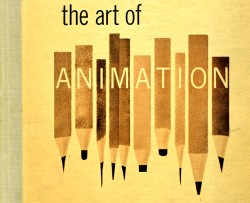 – One of my most treasured gift/memories was receiving a Christmas present of the newly published book, The Art of Animation by Bob Thomas. This came to me in 1958. Prior to receiving it, I had to scour my local public library, as a child, to read about animation. Here was this book that came awfully close to inventing the coffee table book for animated cartoons – which generally meant Disney in those days. Lots of beautifully colored photos of animation artists at work and plenty of Disney cartoon images. It even a filmography for about 100 people who’d worked at the studio, or at least a Disneyography for those people.
– One of my most treasured gift/memories was receiving a Christmas present of the newly published book, The Art of Animation by Bob Thomas. This came to me in 1958. Prior to receiving it, I had to scour my local public library, as a child, to read about animation. Here was this book that came awfully close to inventing the coffee table book for animated cartoons – which generally meant Disney in those days. Lots of beautifully colored photos of animation artists at work and plenty of Disney cartoon images. It even a filmography for about 100 people who’d worked at the studio, or at least a Disneyography for those people.
Don Graham was an art instructor at Chouinard (which eventually became CalArts) when Walt Disney brought him in to supervise night classes for his animators. He was enormously successful and a strong influence on all the young animators, and he continued at the studio until WWII broke out. Disney brought him back to the studio in 1950, and he 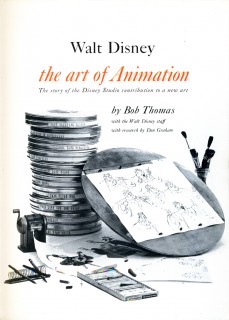 did research for a film on Art. This research was to be a book called “The Art of Animation,” but it never quite gelled to Disney’s satisfaction. (I have a xerox copy in storage and someday I’ll post a bit of it.) He also wrote a book entitled Composing Pictures which instructs in methods of composition.
did research for a film on Art. This research was to be a book called “The Art of Animation,” but it never quite gelled to Disney’s satisfaction. (I have a xerox copy in storage and someday I’ll post a bit of it.) He also wrote a book entitled Composing Pictures which instructs in methods of composition.
When Sleeping Beauty neared its release, Bob Thomas was brought in to write a book about animation that would also focus on Sleeping Beauty. Thomas used some of Graham’s notes for the book he’d been preparing for Disney.
This is the book that was published in 1958.
I suspect that my receiving the book at such a young age made it all the more precious to me, and to this day it gives me positive feelings whenever I hit on certain pages and pictures in it. There’s a photo of Eyvind Earle holding up a cel of one of the three faeries that ALWAYS sends a chill up my back. It strikes to the heart of something I love about animation, and it inspires me like little else can. I can’t say what it is about this picture, but it speaks to me.
I thought it might be entertaining to post a couple of pages from the book. The opening chapter on “Story” seems pertinent since so many of our recent posts have been Bill Peet storyboards. Here’s a bit of his board for Sleeping Beauty.
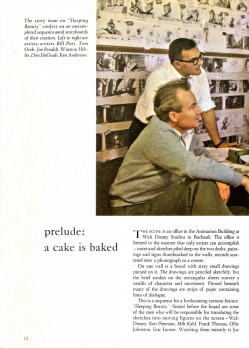 12
12 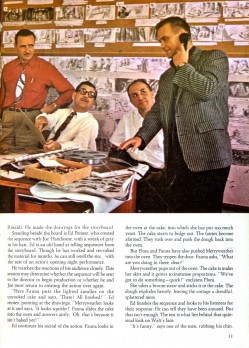 13
13
________(Click any image to enlarge so you can read it.)
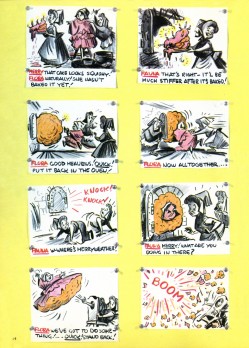 14
14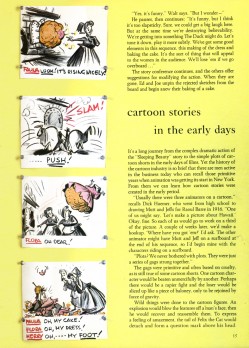 15
15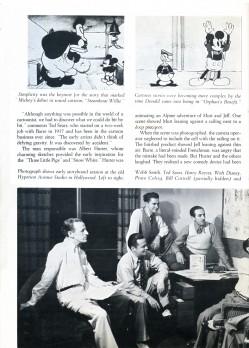 16
16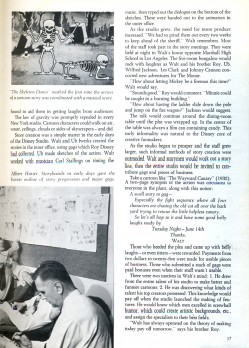 17
17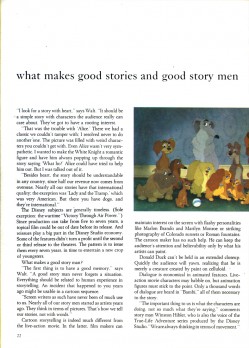 22
22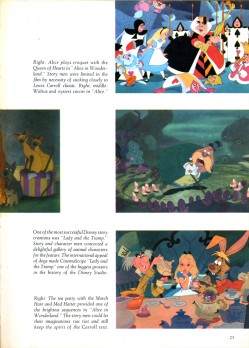 23
23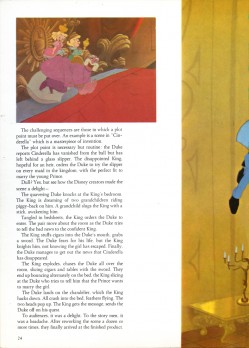 24
24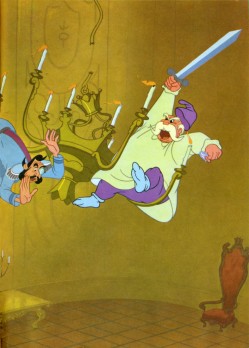 25
25
on 24 Mar 2008 at 9:37 am 1.Doug said …
Michael,
Thanks for this post (and all your others as well). You mentioned Don Graham’s book on composition. Is this a good one? Or would you recommend another more highly? I’d appreciate any recommendations.
..doug
on 24 Mar 2008 at 10:02 am 2.Michael said …
I treasure the book, primarily because of my respect for the author. As a primer on composition it’s excellent but quite dry and technical. To be honest, I’ve rarely found success with books on the artistic process so don’t usually buy them. For better or worse, I’ve learned what I know about composition by studying famous painters and trying it myself.
on 24 Mar 2008 at 10:05 am 3.Mark Mayerson said …
It’s really interesting to me how Walt Disney’s attitude towards publicizing the staff changed in the 1950s. In the 1930s until Snow White, nobody except Iwerks got screen credit. Starting with the features, people got credits, but in the Robert W. Field book, nobody was identified by name. In The Reluctant Dragon, people on screen were still anonymous and you couldn’t even be sure if the person you were looking at was an artist or an actor playing an artist.
Once TV came along, Disney realized that he needed filmed publicity for his films and decided to feature his staff. There are Disneyland episodes like A Story of Dogs, publicizing Lady and the Tramp, which walk the viewer through the whole animation process and feature artists from just about every department. Bob Thomas’s book is really a print version of A Story of Dogs, focusing on Sleeping Beauty instead of Lady and the Tramp.
I guess by the ’50s, Disney was sure of his staff’s loyalty and that his animation competition wasn’t enough of a threat to steal anybody away from him. It’s too bad that the artists had to wait more than 20 years for the acknowledgment they were owed.
on 24 Mar 2008 at 10:17 am 4.Michael said …
That’s a great point, Mark. It’s one I’ve thought about for years. To feature that filmography at the rear of the book was quite stunning. I don’t think any other book since has had such a studio report on the staff’s credits. I’ve used it for years (prior to the internet) to locate a name I didn’t know or might have forgotten. The list certainly isn’t complete, but it was a great start.
on 24 Mar 2008 at 12:59 pm 5.Stephen Worth said …
That section on “what makes a great story man” is great.
Thanks
Steve
on 24 Mar 2008 at 2:32 pm 6.Eddie Fitzgerald said …
This is by far the best coffee table book on animation. It may be the best mass-market coffee table book of any kind, bar none! I wonder what you call the Golden Book printing process they used. Is it lithography of some kind? The colors are great and the paper feels like the kind of paper artists really draw on.
In addition to everything else, the book even feels good in the hand. The size and weight are in perfect balance. You’d think thick paper like that would be heavy but it’s not. What a marvelous example of the bookmaker’s art!
on 24 Mar 2008 at 4:17 pm 7.Tom Minton said …
TIME magazine’s review of the hefty 1973 Christopher Finch “The Art of Walt Disney” book inferred that Finch’s volume uniquely resurrected the names of long-uncredited Disney artists. By that time, the Bob Thomas “The Art of Animation” book was apparently forgotten, because the latter did it first.
on 24 Mar 2008 at 5:13 pm 8.Francesco said …
Mr. Sporn, I happen to have the same edition you have but without its dust-jacket . Since you were given the book as it came out I wonder do you have the book’s dj and, if so, can you post a scan?
Thanks
on 24 Mar 2008 at 5:41 pm 9.Michael said …
I found this image of the dust jacket on line.
The copy I have in my studio is missing the DJ.
on 24 Mar 2008 at 7:26 pm 10.Francesco said …
Thanks. So your copy never had a dj? Is that what you mean?
on 25 Mar 2008 at 8:23 am 11.Michael said …
I have two copies. One was bought new with DJ; one was bought use sans DJ.
on 26 Mar 2008 at 2:19 pm 12.Warren said …
Great post & comments! But the image that’s listed as ’13′ doesn’t work. I’d love to see the look on Joe Rinaldi’s mug!
Cheers,
~w .
on 26 Mar 2008 at 2:43 pm 13.Michael said …
I enlarged the image in #13 (and in fact all of them to check), and it enlarges when you double click. In AOL & IE it enlarges immediately; with Mozilla you have to click it a second time once it goes to the new link. I don’t know why Mozilla works this way, but it does.
on 29 Mar 2008 at 4:24 am 14.Ernesto Pfluger said …
You can find the complete book in spañish, in my long time stopped blog.
Here:
http://cartoonclasico.blogspot.com/search/label/Documentos
on 31 Mar 2008 at 7:39 am 15.Brian Sibley said …
It’s my favourite animation book, too, Michael.
Incidentally, I own the original artwork of Prince Philip fighting the dragon which I bought from a dealer who didn’t know it’s origin…
on 01 Apr 2008 at 6:01 am 16.Mike said …
Thanks for the time in scanning these and thank you for posting these, Michael. I, like Warren, am having trouble with image 13. Though it does enlarge, image 12 appears instead of image 13.
on 01 Apr 2008 at 11:31 am 17.Floyd Norman said …
It’s a great book. I was around when a good deal of the book was being put together inside the studio. I think that was unusual at the time.
But, how’s this? My book is signed by Walt Disney. No, not one of the many guys who often imitated Walt’s signature. I personally took my book to Walt’s office and had him sign it to me.
Now, that’s a treasure.
on 01 Apr 2008 at 12:31 pm 18.Michael said …
You’re just trying to make us all jealous, Floyd, an it’s worked. What a treasure that book is. Envy, envy, envy.
For anyone out there who hasn’t learned, Floyd Norman now has a great new blog. This is something we’ve all been waiting for. It promises to be as great as it already is.
on 18 May 2008 at 5:10 am 19.Gerit said …
I was 12 years old when I saw this book in the local library in 1972. It was without a doubt the key influence that got me interested in animation. The book was nothing less than mesmerizing. The fusion of art, sound, imagination and technology was so manifest and exciting. I need to track down a copy for sure.
Around the same time, the Museum of Natural History in Los Angeles kept some Disney artifacts on display which I went and took pictures of, –primarily a vintage animation stand constructed mostly of wood. There’s a pic of it in the book. I always imagined that Ub Iwerks tinkered on putting that thing together.
on 03 Aug 2009 at 7:30 pm 20.Caroline Thomas said …
My father wrote this book! What nice memories. I’ll forward these to him.
on 05 Apr 2011 at 12:33 am 21.John Webber said …
Michael,
Would you be able to get me a copy of Don Graham’s book, “The Art of Animation”? I used to work with Disney for ten years in their features division and now I am teaching an action analysis class at SCAD. This book would be SO helpful! I promise not to post it! I just need it for some great material to use!
Thank you!
on 05 Apr 2011 at 7:13 am 22.Michael said …
THE ART OF ANIMATION is not by Don Graham, COMPOSING PICTURES is (if you read the post). COMPOSING PICTURES was once on line but had to be taklen down. You can get it at Amazon here. THE ART OF ANIMATION is posted on line here (but it’s not in English.) I have no intention of posting the entire book, myself.
on 07 Apr 2011 at 1:13 am 23.Tom Benthin said …
I believe John Webber was referring to Graham’s unpublished book by the same title (The Art of Animation) that you wrote you had a xeroxed copy of. Would you be willing to post that?
on 07 Apr 2011 at 7:32 am 24.Michael said …
It’s in storage.
on 13 Dec 2011 at 1:02 am 25.Rusty said …
Apologies for asking anything that may already have been answered, but I’ve just discovered this web site. As a kid I did show some potential in drawing, but never pursued it.
I was a CAD designer, but never what I would consider a great one as I learned on the job. I excelled more at Autolisp to speed things up. All that ended back in 2002, but I’m still interested in graphics as I have Blender. But there is a problem. I believe that hand drawing is the avenue I must take to get he most put of any software. Sadly, I’ve become too “wrong brained” so my drawing skills are quite terrible now.
My mother was quite a good cartoonist though she did it for us kids.
Any suggestions on books that might be helpful in developing my drawing skills? And them animation?
Thanks.
on 13 Dec 2011 at 7:58 am 26.Michael said …
Just keep drawing every day, every spare minute. A book won’t teach you how to draw. To Study animation, get Preston Blair’s “Animation” to start with.
on 19 Jan 2012 at 5:55 pm 27.Gijs Grob said …
Sheer jealousy! I wish I had it!